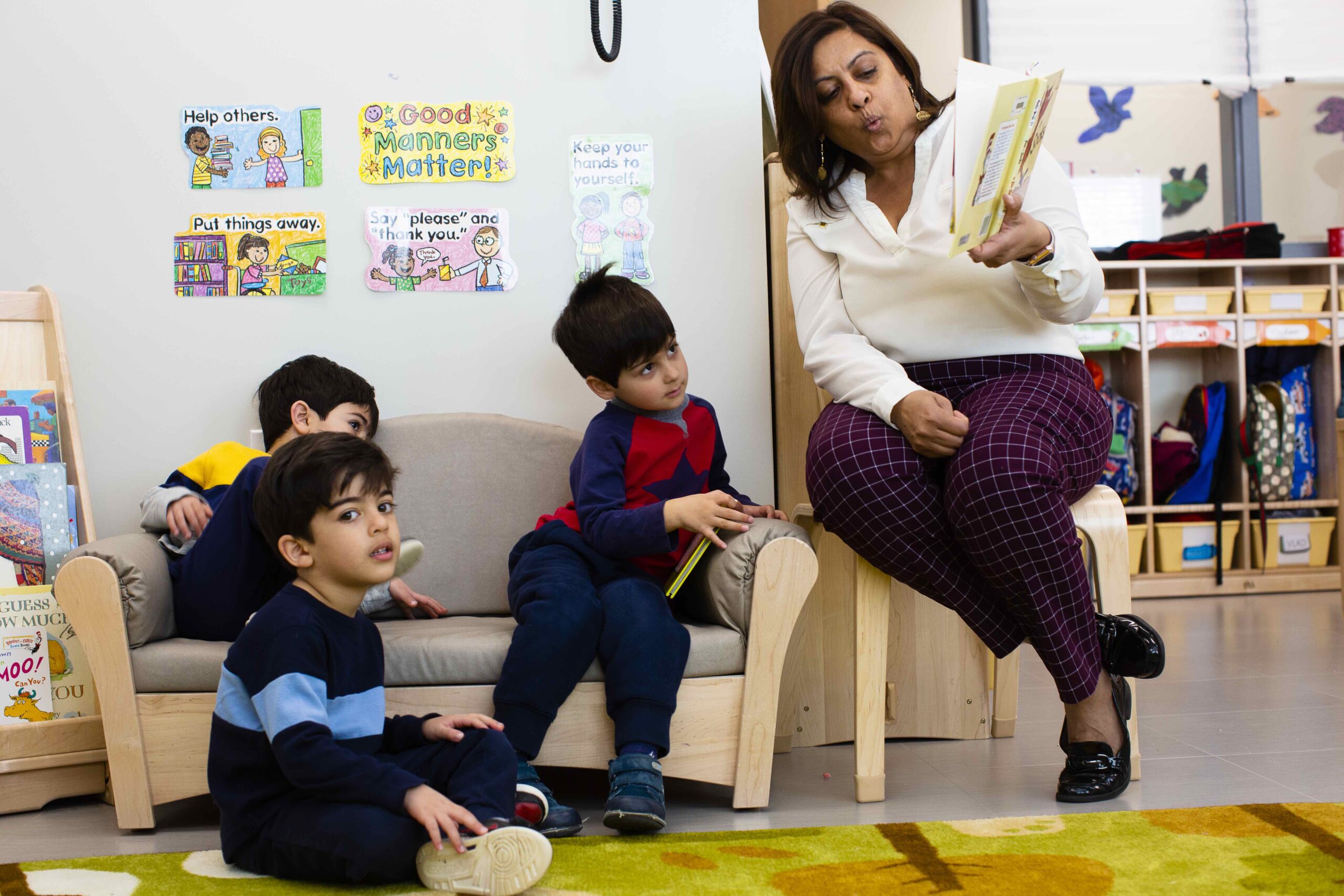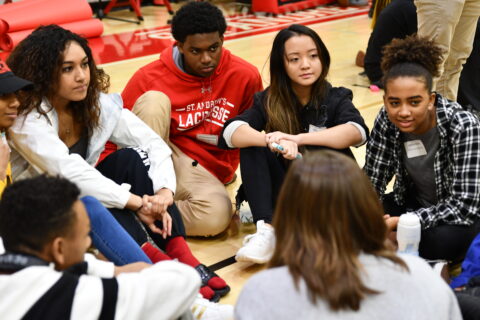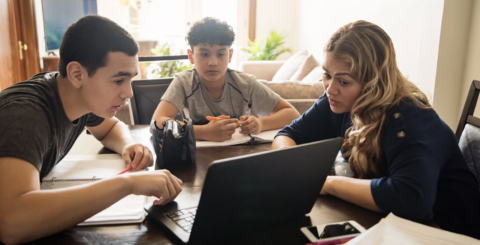In the fall of 2022, we interviewed Kiran Philip, a preschool teacher at St. Andrew’s Episcopal School (MD). Kiran has now entered her 19th year as an educator, and her sixth year at St. Andrew’s. She has contributed to the development of professional learning resources for early childhood and elementary teachers in partnership with The Center for Transformative Teaching & Learning at St. Andrew’s (CTTL) and in July 2023, Kiran served as a translation group leader at the CTTL’s annual Science of Teaching & School Leadership Academy.
CTTL: What are some of the roles you inhabit at St. Andrew’s?
KP: I have been working at St. Andrew’s for the past five years now as a preschool teacher. I work with preschool ages two through four. I have also worked with other age groups at different places. With St. Andrew’s, working with the youngest [learners] was my preference. I’m an adult trainer also for the state of Maryland, and one of the reasons I was attracted to St. Andrew’s is because it’s a research-based school. When I joined, there wasn’t a lot of research around early childhood education, and I came with an aim to advance that research and do things in our classrooms that are research-based.
CTTL: How long have you been an educator, and when was your introduction to Mind, Brain, and Education Science or MBE?
KP: I have been an educator for the past 18 years now. I came as an educator from Pakistan. I was teaching first grade through sixth grade. I moved to this country in 2008. In 2010, I started my undergrad here in early childhood education, and in 2014 I became a trainer of adult teachers. I started training preschool teachers on their growth and development courses and continuing education courses that are required in the state of Maryland. I was a director at a childcare center in 2017 when [I was hired] to teach in a 2-year-old classroom at St. Andrew’s.
CTTL: At what point in your journey were you exposed to Mind, Brain, and Education Science?
KP: My first degree as an undergrad was in Pakistan in biology and chemistry. So, I had some background in the biology of the brain. Practically, the interest started when I started working here at St. Andrew’s.
CTTL: What does your MBE practice look like in application? Are there one or two specific things that you make sure you do with students consistently?
KP: The first thing I learned from Mind, Brain, and Education is safety. In our younger classroom, it is so important for our students to feel safe, and it starts from day one. When they come on the first day, each child – I believe – stands in the doorway and they [scan] the classroom much like adults. They scan the classroom and they find an area that feels safe and they go to that space. When the children feel safe, they’re able to build a connection with us, to use their words to express their feelings, to talk their hearts out with whatever vocabulary they have. And that leads us to be able to offer them a sense of belonging. Those positive experiences are so important right from day one. Once that safety is established, learning falls into place so naturally.
So safety gives them a sense of belonging and a sense of belonging gives them autonomy. I can do anything that I want to in my class. Isn’t that what we all do at home? We can lay down on a couch if we want to; we can start watching a movie. If we feel like eating in our bed, we eat in our bed. That’s who we are; that’s where we belong. So, it is so important for us as educators to understand that we have to be flexible. We have to accept the diverse learners that come into our class, and we have to offer them diverse methodologies and different modalities to learn because not everyone learns in the same way. Some children show interest in numbers by using a pencil, but others may have cars lined up on the table. And they are showing the same interest by using those cars. So, those manipulatives come into play for them. For some, we use songs because they are children that show interest through music and movement. We bring in songs and music at the same time. For some we even used Seesaw a lot during distance learning and for some that interest sparked by watching, by having visuals in front of them. Oh, there’s a puppet that is moving. That puppet is singing a song also, and then a number pops up and it’s the number one. So, there’s a different way to approach that same concept with each and every learner that we get in our classroom. That’s what the CTTL has taught me as a teacher – to individualize and to accept the differences and to really transform our teaching into providing individual experiences to each child and impart knowledge to them.
CTTL: You mentioned the need for the teacher to have flexibility. How do you approach coming into a school year with certain concepts or elements of the learning experience that you want to teach and meeting your students with their diverse learning styles. How do you navigate that with MBE?
KP: When I come in, I don’t come with expectations. I do have expectations that there should be structure, there should be a routine in the classroom, there should be numbers in the classroom, there should be letters in the classroom. Those are the dynamics of the environment that we create. We have a housekeeping area, we have a block area, and that’s a requirement. But, as a teacher, what is my expectation? My expectation is really simple… for my students to understand that this is a place where they can be themselves, where there is kindness, where there is love, where they will be loved. And offering a home away from home. When we build that social and emotional environment in our classroom, I can bring mathematical concepts out. I can put three different kinds of manipulatives out. But, if a child is crying and not feeling safe in my care, then all of that gets set aside. I may have to spend the whole day trying to comfort that child. WIth MBE, I know that positive experience and safe space are two important things that I have to provide. And once I provide that, I then navigate and try to understand each child’s personality traits and their interests.
CTTL: In what ways have you been able to contribute to the creation of the professional development resources that are used in the Lower School? How was that experience for you?
KP: I was involved in creating the effort rubric that’s used in the elementary grades, and I was involved in the design of the Early Childhood [MBE Strategies] Placemat. So, with the effort rubric, they wanted to create a rubric for all grades so that if students were not able to write yet, then even preschool teachers could use it. So, we came up with the youngest classroom – what we do in early childhood. That’s the foundation. We came up with different domains that we want to work in. There was documentation of social-emotional domains and what are the things we do to encourage that and how it relates to MBE. Then, we worked on language, numeracy, and art. For the Early Childhood Placemat, I focused on the research around play. But, the placemat also includes strategies on learner agency and learning environments. One of the things I really enjoyed about doing that research – one of the lines that jumped out at me – was that play acts as fuel for the brain. You can’t run a car without fuel. You can’t have a child sustain throughout the day without having play. And that’s why we consider all our centers, the learning we are offering, should be play-based.
CTTL: What would you consider one of the most important MBE concepts that a new teacher should learn?
KP: I think design plays a very important role. Design covers everything; it covers play and it covers the environment. We design play in our classrooms. We talk about play plans with our students. They are involved in that planning. I would encourage a new teacher to learn about how to design play in the classroom. As an early childhood educator it is a skill. Play can be object play, sensory play or guided play. Play can also be structured or unstructured. It will be so important for a new teacher. Designing play helps to understand the cognitive processes that will be accelerated or addressed.
CTTL: How do you communicate the value of MBE to parents?
KP: Everything we do has research behind it; that’s what we communicate to our parents. We support them with language, and we provide them with appropriate strategies that are supported with research.




